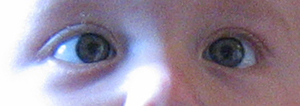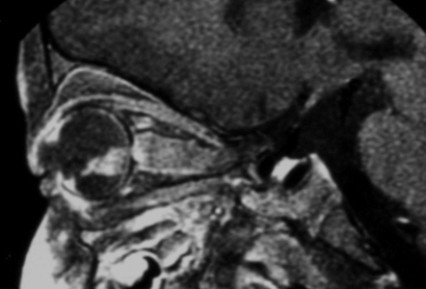Retinoblastoma
Retinoblastoma (Rb) is a rare and aggressive form of cancer that originates from the immature cells of the retina, the light-detecting tissue of the eye. It predominantly affects young children and is the most common primary malignant intraocular cancer in this age group. While most children in high-income countries survive the disease, they may experience vision loss or require enucleation of the affected eye.
Signs and Symptoms

Retinoblastoma often presents with leukocoria, an abnormal white reflection from the retina seen through the pupil. Other symptoms include poor vision, eye pain, and strabismus (crossed eyes). In advanced stages, signs such as a red and irritated eye with glaucoma or eye enlargement may be observed. Early detection through routine paediatric vision screenings can lead to more favourable outcomes.
Cause
Retinoblastoma is primarily caused by mutations in the RB1 gene on chromosome 13, which functions as a tumour suppressor. These mutations can be hereditary or sporadic.
RB1
In hereditary cases, a defective RB1 gene is inherited or occurs early in foetal development. The gene's inactivation leads to uncontrolled cell growth. Bilateral retinoblastomas are often hereditary, while unilateral cases are typically sporadic.
MYCN
A subset of non-hereditary retinoblastomas is associated with MYCN oncogene amplification. This form is aggressive and often presents in infants younger than six months.
Diagnosis

Diagnosis involves a combination of eye examinations and imaging studies. Tools such as ophthalmoscopes, retinoscopes, and imaging modalities like MRI, ultrasound, and CT scans help in identifying the presence and extent of the tumour. Genetic testing for RB1 mutations is essential for understanding hereditary risks and guiding family planning.
Morphology
Macroscopically, retinoblastoma tumours are characterised by viable cells near blood vessels and zones of necrosis in avascular areas. Microscopically, undifferentiated cells and differentiated elements such as Flexner-Wintersteiner rosettes are observed.


Genetic Testing
Identifying RB1 mutations in affected individuals allows for targeted screening of siblings and offspring, reducing unnecessary examinations. Prenatal testing can also aid in early intervention and better visual outcomes.
Imaging
High-resolution ultrasound and MRI are preferred for their detailed imaging capabilities and ability to detect high-risk features like optic nerve invasion. CT scans are generally avoided to prevent radiation-induced tumour formation.

Staging
The International Classification for Intraocular Retinoblastoma categorises tumours from very low to very high risk based on size, location, and presence of seeding. This staging system guides treatment decisions.
Treatment

Treatment aims to preserve life, vision, and minimise side effects. Options include enucleation, external beam radiotherapy (EBRT), brachytherapy, thermotherapy, laser photocoagulation, cryotherapy, systemic chemotherapy, intra-arterial chemotherapy, nanoparticulate chemotherapy, and chemoreduction. The choice of treatment depends on the tumour's characteristics and the patient's overall health.
Prognosis
In developed countries, retinoblastoma has a high cure rate of 95-98%, with most survivors reaching adulthood. Early detection is very important for a favourable outcome. However, survivors of hereditary retinoblastoma have an increased risk of secondary cancers.
Epidemiology
Retinoblastoma affects one in 18,000 to 30,000 live births worldwide, with a higher incidence in developing countries. Most cases are diagnosed before the age of three, with bilateral cases presenting earlier than unilateral ones.
Self-assessment MCQs (single best answer)
Which of the following is the most characteristic sign of retinoblastoma?
Retinoblastoma primarily arises due to mutations in which gene?
What type of retinoblastoma is most often associated with the MYCN oncogene amplification?
Which imaging modality is generally avoided in diagnosing retinoblastoma due to the risk of radiation-induced tumour formation?
What is the primary goal of retinoblastoma treatment?
What is the preferred method for high-resolution imaging in retinoblastoma to detect high-risk features like optic nerve invasion?
Which of the following is NOT a typical treatment option for retinoblastoma?
At what age are most cases of retinoblastoma diagnosed?
What is the cure rate for retinoblastoma in developed countries?
Which of the following is a key feature observed microscopically in retinoblastoma?
Dentaljuce
Dentaljuce provides Enhanced Continuing Professional Development (CPD) with GDC-approved Certificates for dental professionals worldwide.
Founded in 2009 by the award-winning Masters team from the School of Dentistry at the University of Birmingham, Dentaljuce has established itself as the leading platform for online CPD.
With over 100 high-quality online courses available for a single annual membership fee, Dentaljuce offers comprehensive e-learning designed for busy dental professionals.
The courses cover a complete range of topics, from clinical skills to patient communication, and are suitable for dentists, nurses, hygienists, therapists, students, and practice managers.
Dentaljuce features Dr. Aiden, a dentally trained AI-powered personal tutor available 24/7 to assist with queries and provide guidance through complex topics, enhancing the learning experience.
Check out our range of courses, or sign up now!


